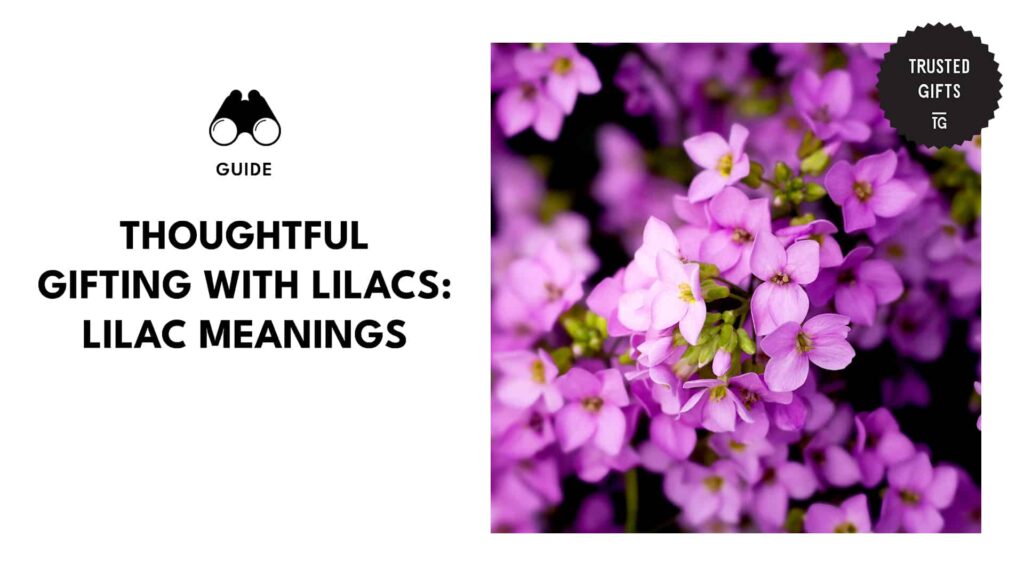The lilac flower is a living masterpiece of nature with its vibrant hues and delicate, tender fragrance that fills the air with powdery sweetness.
Each fragrant petal also speaks of joy, love, youth, and new beginnings, which makes lilac flowers the perfect gift for your loved ones.
In this article, we will reveal everything you need to know about the lilac flower’s meanings, origin, cultural significance, and various uses. We will also provide tips on the best ways to gift them.
How did the lilac flower get its name?


The lilac flower’s scientific name, Syringa, comes from the Greek word “syrinks.” This term means “pipe” and refers to the hollow branches of the flower.
Its common name “lilac,” comes from the Persian word “lilaq,” which means flower.
What are the botanical origins of the lilac flower?


The lilac flower, belonging to the Syringa genus and the Oleaceae family, is a flowering plant that is native to Eastern Europe.
It can grow up to 23 ft. tall with flowers that come in various colors such as blue, purple, white, and pink.
Where do lilac flowers grow?
Lilac flowers grow on rocky hills in areas with temperate climates. They are widely cultivated in Europe, Asia, and North America.
Do lilac flowers require a lot of maintenance?
Once established, lilac flowers are low-maintenance. Aside from regular watering and sun exposure, they only need regular pruning to promote blooms.
Do lilac flowers need shade or sun?
Lilac flowers grow best in full sun with at least 6 to 8 hours of daily exposure. They can tolerate some shade, but they only produce fewer flowers in this condition.
When do lilac flowers bloom?
Lilac flowers typically bloom in early to late spring. These flowers only have a short blooming time, which can last about three to four weeks.
What kind of soil do lilac flowers prefer?
Lilac flowers prefer well-draining, loamy soil that’s rich in nutrients with a pH level between 6.5 to 7.0. They can tolerate clay soil, but growing them in this type of soil might stunt their growth.
When is the best time to plant lilac flowers?
Lilac flowers can be planted during the spring when the soil has thawed or in the autumn before the ground freezes.
What do lilac flowers mean?


Lilac flowers stand for joy, youth, love, purity, innocence, and love. Since they bloom in spring, they are also seen as symbols of new beginnings and renewal.
Lilacs are also considered the official 8th wedding anniversary flowers.
What do the colors of lilac flowers mean?
White


White lilac flowers symbolize purity, innocence, youth, and new beginnings.
Recommended use: White lilacs are the perfect gifts for marking new and significant life events like weddings, moving to a new home, and baby showers.
Pink


Pink lilac flowers symbolize friendship.
Recommended use: These flowers are the perfect gifts to friends to brighten up their day.
Purple


Purple is the most common color of lilacs.
The lighter shade of purple symbolizes first or young love. The deeper shade of purple symbolizes spirituality, royalty, and nobility.
Recommended use: A bouquet of light purple lilacs is a perfect choice to gift your first love on a date.
Deeper purple lilacs are a great choice when celebrating Easter and other religious celebrations.
Blue


Blue lilac flowers stand for happiness and tranquility.
Recommended use: This flower is the perfect gift for someone who is going through a stressful time to send a sense of serenity and calmness their way.
Magenta


Magenta lilac flowers symbolize love and passion.
Recommended use: These flowers are the perfect gifts for your partner on dates, anniversaries, or Valentine’s Day.
What did lilac flowers symbolize in various historical periods?


What are the cultural associations of lilac flowers?


What are the uses of lilac flowers?


Lilacs are not just beautiful, fragrant flowers that are rich in meaning and symbolism. They are also very useful when it comes to cooking, medicine, gardening, and landscaping.
How can lilac flowers be used in cooking?


Lilac flowers have a sweet floral flavor with faint citrus notes. Here are some creative ways to use them in the kitchen:
- Infuse them in syrups and honey: Harvest fresh lilac blooms and infuse them into syrups or honey.
This floral infusion can add a hint of sweetness and a unique floral undertone to your beverages, desserts, or even drizzled over pancakes or waffles.
- Infuse butter with lilacs: Elevate your culinary supplies by infusing butter with lilac blossoms.
Lilac-infused butter is ideal for spreading on bread or incorporating into baked goods to add a subtle floral note that enhances the overall taste.
You can also combine lilac-infused honey with softened butter to create a delectable spread for bread, muffins, or scones. This combination creates a perfect balance of sweetness and floral richness.
- Blend them with sugar: Create a fragrant lilac sugar by blending fresh lilac petals with granulated sugar. This aromatic sugar can be used to sweeten teas, sprinkle over desserts, or add a floral touch to your favorite baked treats.
- Brew them into beverages: Brew lilac flowers into teas, lemonades, or cocktails for a refreshing and aromatic twist. Experiment with combinations to discover your preferred lilac-infused beverage.
- Infuse vinegar with lilac: Infuse vinegar with lilac blossoms to create a unique flavor to it. Lilac-infused vinegar can be used in salad dressings, marinades, or even as a drizzle over roasted vegetables.
- Add lilac essence to ice cream or sorbet: Transform your homemade ice cream or sorbet by adding lilac essence to your recipe. The subtle floral notes will add a touch of sophistication to your frozen desserts.
- Use lilacs as a garnish: Use lilac flowers as an edible garnish for salads. Their delicate appearance and mild flavor can complement both green salads and fruit salads and add an aesthetic and tasty element.
Can lilac flowers be used for medicinal purposes?


Yes, lilac flowers can be used for medicinal purposes. Here’s how:
- Digestive Aid: Lilac flowers are believed to have digestive benefits. Drinking lilac-infused teas has been historically associated with alleviating digestive issues, including indigestion and bloating.
- Skin Health: The extracts from lilac flowers contain compounds that are believed to be beneficial for the skin.
From soothing irritations to promoting overall skin health, lilac-infused products, such as creams or balms, offer a natural and gentle solution for various skin concerns.
- Aromatherapy and Stress Reduction: The fragrant essence of lilac flowers has aromatherapeutic qualities.
Inhaling the pleasant aroma of lilac is believed to contribute to stress reduction and relaxation, and provides a soothing experience for both the mind and body.
- Respiratory Health: Lilac flowers, when used in herbal formulations or teas, have been historically associated with respiratory health benefits.
They are believed to contribute to easing respiratory discomfort and promoting clearer breathing.
Remember, when using lilac flowers for medicinal purposes, it’s best to consult with a qualified healthcare professional.
How can lilac flowers be used in gardening and landscaping?


Lilac flowers can bring a burst of beauty and fragrance to your outdoor spaces. Here’s a closer look at how you can use them to enhance your gardening and landscaping:
- Plant them as borders: Plant lilac shrubs along the borders of your garden beds or pathways to create vibrant edges. The varying colors of lilac flowers can define spaces and add a pop of color to your landscape.
- Use them as fragrant focal points: Position lilac shrubs strategically as focal points in your garden.
Their fragrant blooms will not only draw attention but also provide a delightful aroma that enhances the overall sensory experience of your guests.
- Attract pollinators with lilacs: Cultivate a pollinator-friendly garden by planting lilacs. Bees and butterflies are attracted to the nectar-rich flowers which contribute to a healthier ecosystem and encourage biodiversity.
- Use them for complementary plantings: Pair lilac shrubs with companion plants, such as daffodils, peonies, and lavender, to create visually appealing combinations.
- Plant them in containers: Cultivate lilac varieties that are suitable for container gardening like the dwarf Korean lilac and Tinkerbelle lilac.
This will allow you to enjoy the beauty and fragrance of lilacs even if you have limited space or want to accentuate specific areas, such as a patio or balcony.
- Plant them along walkways: Plant lilac shrubs along walkways to create enchanting passages. The overhanging branches and fragrant blossoms can transform a simple stroll into a delightful experience.
- Plant them in cottage gardens: Use the timeless appeal of lilac flowers in a cottage garden setting. Their classic beauty and rustic charm make them a perfect fit for this style of gardening.




